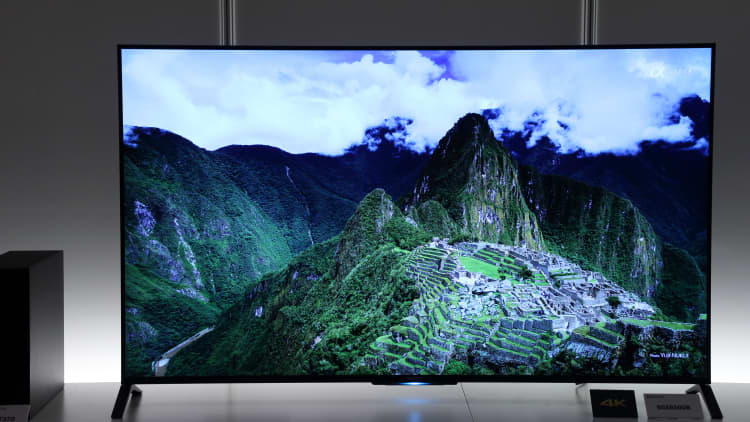
The next big thing in home entertainment this holiday shopping season is likely to be the ultra high-definition 4K television. Or maybe not.
The consumer electronics industry, which has touted the system with images four times sharper than current flat-screen HD pictures, forecasts a surge in revenue this year, driven partly by 4K. Prices are down also, which could be enough to entice viewers to take the plunge and replace the HD set they bought before the recession.
In just two years, prices for the 4K declined by more than 85 percent worldwide, falling from $7,851 in 2012 to $1,120 in 2014, according to market research firm NPD. In North America the price decline was even bigger, dropping 89 percent, from $18,668 to $1,986, during the same period.

But some industry experts liken 4K to the last big breakthrough, 3-D TV, which has not caught on, and warn that it might take a few more years before there is enough 4K content to make it worth shelling out a lot of money for. Some high-end Smart TV models that have massive screens and added features, like Wi-Fi and Web browsers, have price tags over $25,000.
Read MoreGoogle's secret brainchild: Giant TV technology
"4K TVs will exceed everyone's expectations for sales results," Stephen Baker, vice president of industry analysis at NPD, boldly forecasted. "I'm not saying that by the end of the season, after the Super Bowl, that a certain percentage of Americans will have 4K, but from the industry perspective, it will help drive revenues."
But Joel Espelien, a senior adviser for The Diffusion Group (TDG), a Texas-based research firm that studies the consumer TV and video field, is not so sure Americans are willing to go all out for 4K boob tubes, at least not this Christmas.
"I consider myself a 4K realist, and some of the things you hear out there are just cheerleading," he told CNBC. "It's all a bit overblown, but there is also a lot of skepticism; the truth is somewhere in the middle."
In fact, a TDG survey earlier this year found only 6 percent of broadband homes are "moderately" or "highly likely" to buy a 4K TV, and 83 percent of consumers are completely unfamiliar with the term Ultra HD.
(For techies, Ultra HD has a resolution of 3840 pixels × 2160 lines. It has twice the horizontal and vertical resolution of the 1080p HDTV format, with four times as many pixels overall.)
Samsung now sells several 4K models for less than $2,000, with one as low as $899, but it also has an 85-inch screen job that retails at $38,990. Sony, LG, Panasonic and Toshiba are also in the marketplace with 4K televisions, and you can pick up a 50-inch Sekei for just $800.
The Consumer Electronics Association is expecting big things from 4K as fewer TVs are being sold around the world. "Ultra HD TV and 3-D printers are generating tremendous consumer excitement and cementing their place as the next generation of 'must have' products," Gary Shapiro, the association's president and CEO, said recently.
"The continued market growth of Ultra HD TV is performing better than initially projected in 2014," the CEA said when it updated its forecast for this year. Unit shipments of Ultra HD displays are expected to reach 800,000 in 2014, earning $1.9 billion in revenue, a 517 percent increase over the 2013 total. And it expects revenue from 4K sets to exceed $5 billion in 2015, up from virtually nothing in 2012.
The CEA says TV sales remain critical to the industry's overall bottom line, with total TV sets and displays projected to reach $18.4 billion in 2014, down 5 percent from 2013. LCD TVs will account for 94 percent of all digital display sets sold this year, with 36.7 million units expected to ship in 2014. That total will produce $17.3 billion in revenue, in line with 2013 levels as the third-highest revenue driver to the industry.
The new U.S. Consumer Electronics Sales and Forecasts report projects that total industry revenue, including televisions, will reach a record $211.3 billion in 2014; a steady 2 percent increase from $207 billion in sales in 2013. Looking ahead to 2015, the CEA expects total industry sales to grow by 1.2 percent, with industry revenues reaching another all-time high of $214 billion.
This is what gives NPD's Baker optimism about 4K television's future. "I have not heard a lot of naysayers about 4K, in contrast to 3-D, which everyone knew was a gimmick," he told CNBC.com.
"No. 1, it's a great picture—everything looks better—that's what sets 4K apart. It appeals to the higher end, probably an older demographic, with money to spend."
To that, TDG's Espelien replies: "This is going to be a very niche market. It's really a status symbol, something to show off to your friends."
But he does see 4K TV growing as more content and streaming becomes available. At the moment, he noted, there is no 4K pay TV or Blu-Ray discs. Only a few shows on Netflix for a few people with the very fast bandwidth the system requires.
"By the end of next year, we may actually have 4K Blu-Ray, so by Christmas 2015, it may be worth it, but not this year," said Espelien. He noted that the average life span of a television set is seven to 10 years, which begs the question: Why would consumers invest in a product that is not yet complete?
"All I can say is, in seven or 10 years, is I am certain there will be 4K content," Epselien said.
"But marketing a device with sex-appeal for the future generally does not work with consumer products," he said. "The jury's still out."





